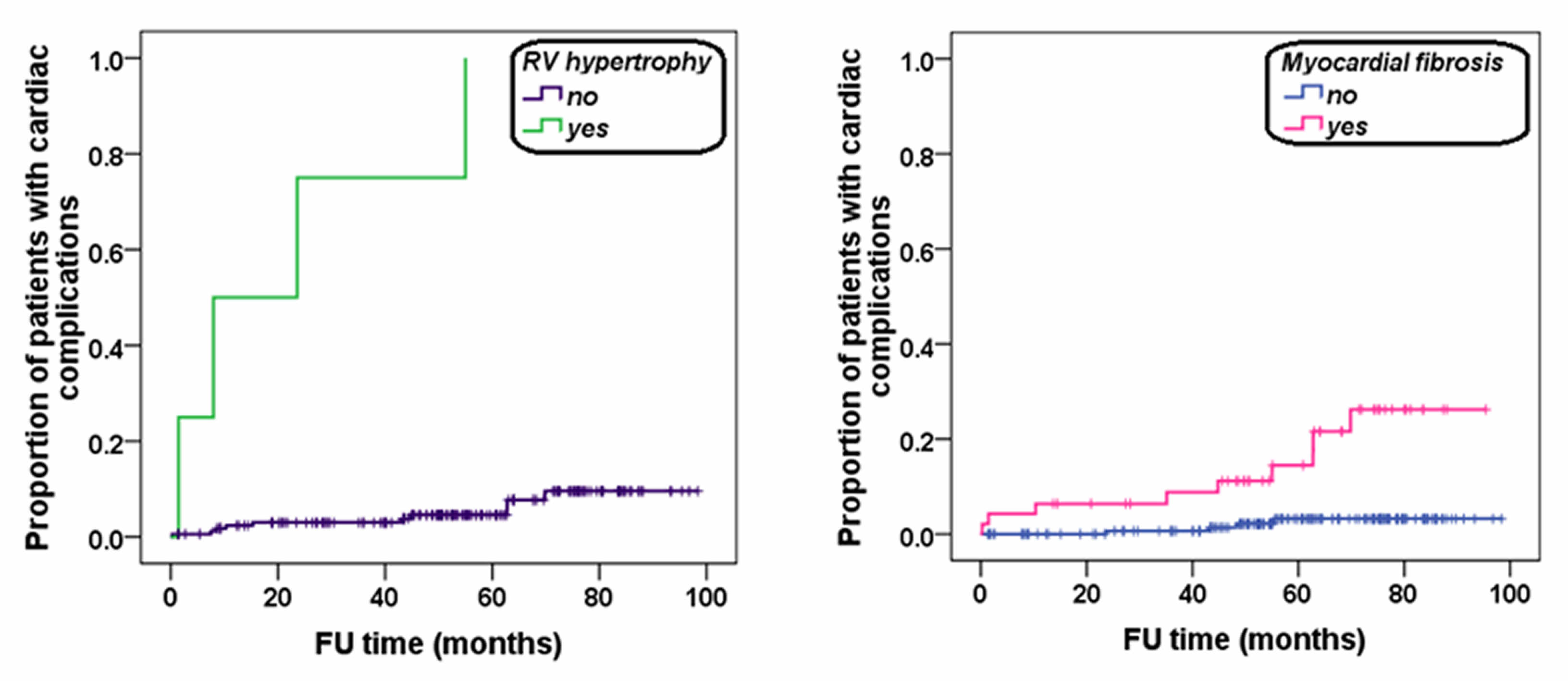
Contributions
Type: Publication Only
Background
Cardiovascular Magnetic Resonance (CMR) has an established role in managing and predicting prognosis of patients with Thalassemia Major (TM). Thalassemia Intermedia (TI) is a milder variant of beta-thalassemia showing a different clinical and prognostic profile; pulmonary hypertension (PH) is a more common complication in TI patients.
Aims
We prospectively determined the predictive value of CMR parameters, including measurement of right ventricular mass, for cardiac complications in TI.
Methods
We considered 342 TI patients enrolled in the Myocardial Iron Overload in Thalassemia network; about half of them (178/302, 58.9%) became transfusion-dependent in the adult age. Myocardial and liver iron overload were measured by T2* multiecho technique. Atrial dimensions, left and right ventricular mass and systolic function were quantified by cine SSFP images. Late gadolinium enhancement (LGE) images were acquired to detect myocardial fibrosis.
Results
Twenty-three patients were excluded because a cardiac complication was present at the time of first CMR, so we prospectively followed 319 patients.
All 319 patients were white, with a mean age at time of their first scan of 38.02±11.69 years and 165 (51.7%) of them were females.
Mean follow-up time was 52.24±24.87 months (median 54.64 months).
Cardiac events were recorded in 22 patients (6.9%): heart failure (HF) in 1 patient, arrhythmias in 12 patients, pulmonary hypertension (PH) in 7 patients and myocardial infarction (MI) in 2 patients.
The mean time from the first MR scan to the development of a cardiac complication was 30.77±23.48 months and 8 (36.4%) cardiac events occurred within the first year of follow-up.
Significant myocardial iron overload (global heart T2* < 20 ms), ventricular dilation, right ventricular (RV) hypertrophy, myocardial fibrosis and atrial dilation were identified as univariate prognosticators.
In the multivariate analysis the independent predictive factors were RV hypertrophy (HR=24.12, 95% CI=5.09-114.12, P<0.0001) and myocardial fibrosis by LGE (HR=6.59, 95% CI=1.33-32.67, P=0.021). The Figure displays the Kaplan–Meier curves showing the impact of each predictive factor on the development of cardiac complications. The log-rank test revealed a significant difference in the curves for each predictor factor (RV hypertrophy: P<0.0001 and myocardial fibrosis: P<0.0001).
Summary
For the first time we studied the prognostic value of right ventricular mass as part of multiparametric CMR imaging in a population of TI patients. Both RV hypertrophy and fibrosis detected by LGE were independent predictive factor for cardiac complications. Measurement of RV mass should be part of the multi-parametric CMR study of patient with thalassemia intermedia.
Keyword(s): Magnetic resonance imaging, Prognosis, Thalassemia

Type: Publication Only
Background
Cardiovascular Magnetic Resonance (CMR) has an established role in managing and predicting prognosis of patients with Thalassemia Major (TM). Thalassemia Intermedia (TI) is a milder variant of beta-thalassemia showing a different clinical and prognostic profile; pulmonary hypertension (PH) is a more common complication in TI patients.
Aims
We prospectively determined the predictive value of CMR parameters, including measurement of right ventricular mass, for cardiac complications in TI.
Methods
We considered 342 TI patients enrolled in the Myocardial Iron Overload in Thalassemia network; about half of them (178/302, 58.9%) became transfusion-dependent in the adult age. Myocardial and liver iron overload were measured by T2* multiecho technique. Atrial dimensions, left and right ventricular mass and systolic function were quantified by cine SSFP images. Late gadolinium enhancement (LGE) images were acquired to detect myocardial fibrosis.
Results
Twenty-three patients were excluded because a cardiac complication was present at the time of first CMR, so we prospectively followed 319 patients.
All 319 patients were white, with a mean age at time of their first scan of 38.02±11.69 years and 165 (51.7%) of them were females.
Mean follow-up time was 52.24±24.87 months (median 54.64 months).
Cardiac events were recorded in 22 patients (6.9%): heart failure (HF) in 1 patient, arrhythmias in 12 patients, pulmonary hypertension (PH) in 7 patients and myocardial infarction (MI) in 2 patients.
The mean time from the first MR scan to the development of a cardiac complication was 30.77±23.48 months and 8 (36.4%) cardiac events occurred within the first year of follow-up.
Significant myocardial iron overload (global heart T2* < 20 ms), ventricular dilation, right ventricular (RV) hypertrophy, myocardial fibrosis and atrial dilation were identified as univariate prognosticators.
In the multivariate analysis the independent predictive factors were RV hypertrophy (HR=24.12, 95% CI=5.09-114.12, P<0.0001) and myocardial fibrosis by LGE (HR=6.59, 95% CI=1.33-32.67, P=0.021). The Figure displays the Kaplan–Meier curves showing the impact of each predictive factor on the development of cardiac complications. The log-rank test revealed a significant difference in the curves for each predictor factor (RV hypertrophy: P<0.0001 and myocardial fibrosis: P<0.0001).
Summary
For the first time we studied the prognostic value of right ventricular mass as part of multiparametric CMR imaging in a population of TI patients. Both RV hypertrophy and fibrosis detected by LGE were independent predictive factor for cardiac complications. Measurement of RV mass should be part of the multi-parametric CMR study of patient with thalassemia intermedia.
Keyword(s): Magnetic resonance imaging, Prognosis, Thalassemia



